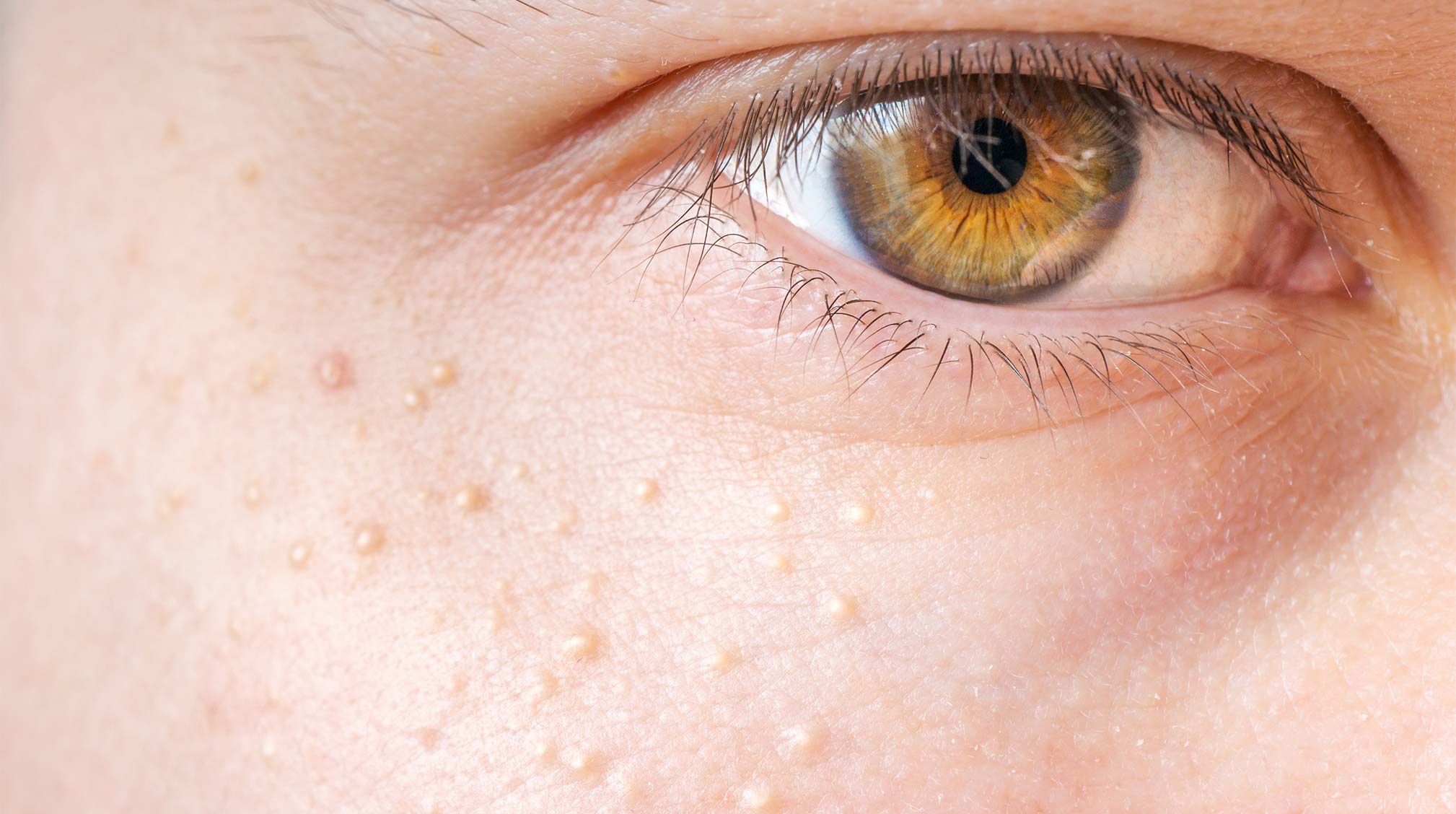
When my tween son (who had never broken out before) came to me one morning asking for a Mighty Patch, I naturally examined the pimple in question. It sort of looked like a whitehead in the making, but felt harder than a pimple when I pressed on it. I briefly panicked, thinking that it might be a return of the molluscum contagiosum he had in his preschool days (then proceeded to break into a cold sweat as I remembered all the apple cider vinegar, cotton balls, medical tape and general angst we went through that year).
Luckily, it was not molluscum. His pediatrician called it milia and said it would probably go away on its own in a month or two. And it did.
If you’ve ever had white bumps on your face that looked kinda like whiteheads, you may have tried to pop or patch them — to no avail. Why don’t acne treatments work? What exactly is milia? And one or two months is a long time to wait — are there milia treatments that work faster? Read on for the skinny on milia and how you can get rid of those tiny white bumps once and for all.
What are those small bumps on my face, if not acne?
“Milia are small epidermoid cysts, aka thin-walled balls of keratin, that sit under the top layers of the skin,” explains Dr. Tsippora Shainhouse, a Beverly Hills-based, board-certified dermatologist. Don’t be alarmed by the word “cyst” though; milia are completely harmless and no cause for concern.
“Milia tends to develop on the face (cheeks, eyelids, nose, chin) as 1-2 mm, white-yellow bumps,” continues Shainhouse. “They can develop under the eye, but in adult women, those bumps are usually another benign skin condition called syringoma.”
How are milia different from closed comedones?
“Milia is different from closed comedones, which is another term for whiteheads,” says Dr. Anna H. Chacon, a board-certified dermatologist who serves on the advisory board for Smart Style Today. “Clinically — on exam — when looking at someone’s face, they actually look very similar.”
The difference is what’s inside. Comedonal acne develops when pores become clogged with excess sebum and dead skin cells. If a thin layer of skin covers the top of the pore, it is a whitehead, or closed comedone.
Milia contain keratin (naturally occurring skin protein), which has collected in a thin-walled cyst. Unlike whiteheads, they feel hard to the touch and you cannot “pop” them (so please don’t try, or you will end up with major damage to the surrounding skin).
RELATED READ: Open, Closed, WTH Are Comedones?
What causes milia?
While milia can appear for no particular reason, they often pop up when keratin gets trapped under the skin after trauma. “They can develop in adults due to aggressive or irritating cosmetic procedures (dermabrasion, chemical peels, ablative laser treatment, tattoos) or within healing blisters and scars,” says Shainhouse. Regular use of topical steroids or hydroquinone can also cause milia to develop. Milia are quite common in newborns, occurring so frequently that the tiny bumps all over their faces are often referred to as “milk spots.”
Milia treatment and prevention
If you don’t want to wait a month or so for milia to resolve on their own, you do have options. “My favorite way of removing them is to take a small gauge needle and poke a hole at the top,” says Chacon. “Then I take a comedone extractor and push the rest of its content out. Please note, do not try this method at home, as all of our tools are sterilized. When people try these techniques at home or in their bathroom, they run the risk of unwanted scarring or an increased risk of infection.”
If you’re curious what a milia extraction looks like, you can watch Dr. Pimple Popper tackle milia removal here. That definitely seems like something best left to professionals!
If needles aren’t your thing, Dr. Shainhouse shared her top three tips for treating milia at home:
- Topical alpha hydroxy acids (AHAs), like glycolic and lactic acid are mild exfoliants that can encourage the milia to come to the surface and eventually pop out. Try an AHA toner or peel twice a week, or look for a face lotion containing AHAs.
- Salicylic acid spot treatments can help to slowly thin out the layers of skin that are trapping the milia cyst. Apply directly to milia at nighttime.
- To prevent new milia from forming, topical retinoids encourage cell turnover, reduce the stickiness of skin cells in the pore, and help reveal a fresh new layer of skin.
Lastly, if sunscreen isn’t already a regular part of your routine, preventing milia is just another one of the many reasons to get in the habit of applying your daily SPF! UV damage to your skin can cause milia formation. There are plenty of lightweight, non-greasy options that won’t cause breakouts — check out our suggestions here. 🌞













